Hello, fellow plant enthusiasts!
Let’s talk about the bad boys of the plant world. You know the ones. The plant version of that roommate who eats all your food, leaves dirty dishes in the sink, and never vacuums. Yes, we’re talking about invasive plants today!
They might look attractive in the garden center, but once you plant them in your garden, it’s game over.
So, pull up a chair, put on your reading glasses, and let’s dive in.
1. English Ivy (Hedera helix)
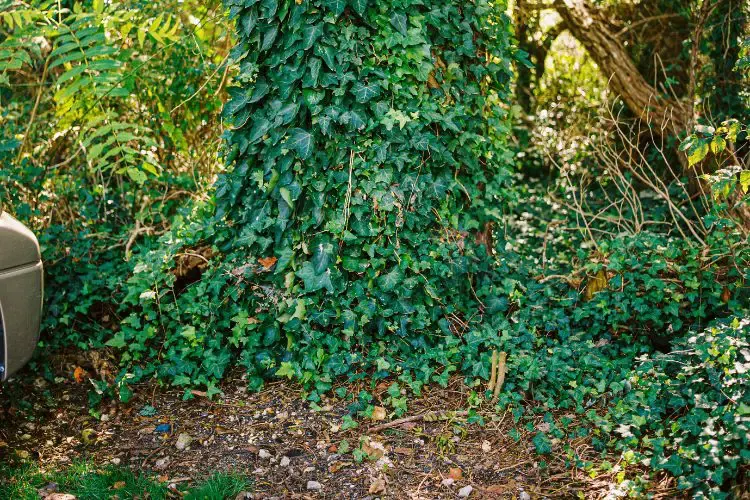
Ah, English Ivy. Sounds quite classy, doesn’t it? Like it spends its weekends at polo matches, sipping on tea. But in reality, it’s more like a squatter that refuses to leave your property.
It climbs over everything – your lovely ornamental trees, your carefully built fences, even your charming garden gnome. It might look innocent enough with its glossy leaves and its hardy nature. But be warned. This plant can grow faster than the speed of gossip in a small town.
Your treasured flower beds? Soon to be swallowed whole. Your brick walls? More like a jungle gym for this green intruder. It also spreads its seeds far and wide, meaning your neighbor’s garden might soon fall victim as well.
And oh, did I mention? It’s incredibly difficult to eradicate. Once it’s entrenched in your garden, it’s about as easy to remove as chewing gum from hair. So, think twice before inviting this overzealous climber into your garden.
2. Bamboo (Various Species)
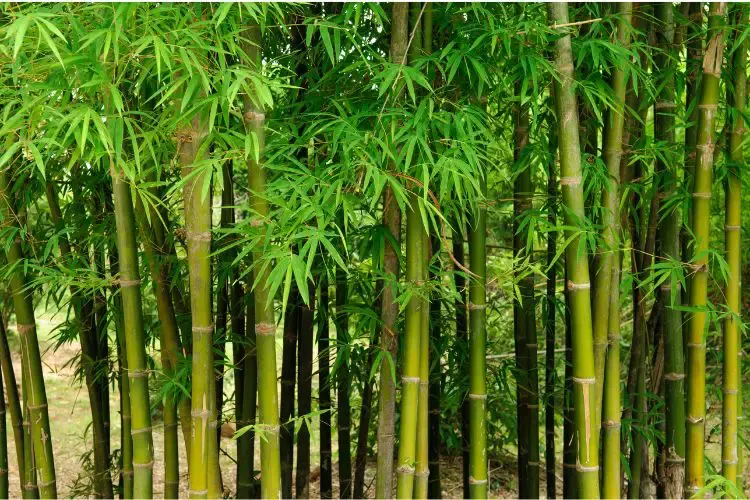
And now, we arrive at bamboo. It looks serene and zen, doesn’t it? Like it meditates daily and eats a plant-based diet. But trust me, it’s as invasive as a salesman at closing time.
There are a few species of bamboo that are okay, but some, like running bamboo, can take over a garden faster than a cat pouncing on a laser pointer. It grows tall, it grows thick, and before you know it, your garden resembles a scene from “Crouching Tiger, Hidden Dragon.”
You may have planted it for a bit of privacy, but it won’t stop there. It’ll invade your flower beds, your vegetable garden, and it might even make a bid for your home if you’re not careful. And trying to get rid of it? You’d have more luck trying to herd cats.
Now, if you absolutely MUST have bamboo in your garden, go for a clumping variety. They’re less invasive but still give you that tranquil, “I’m in a peaceful Japanese garden” vibe.
3. Purple Loosestrife (Lythrum salicaria)
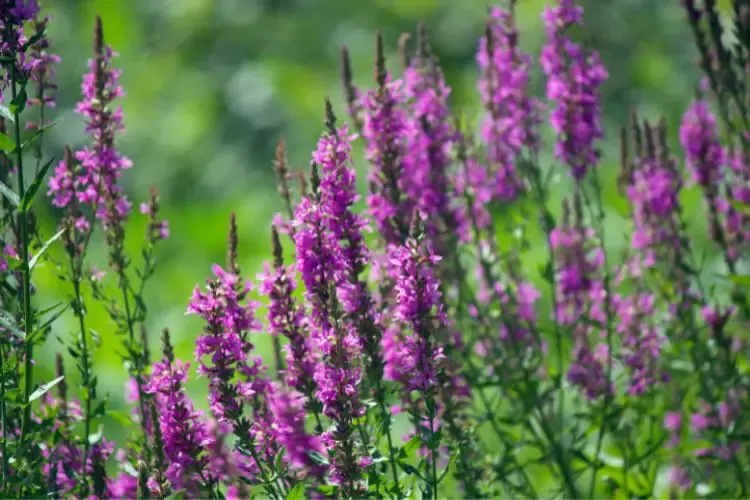
Next up is the beautiful, but oh-so-deceptive Purple Loosestrife. This perennial looks as innocent as a child eating ice cream, but don’t let its pretty flowers fool you. It’s an aggressive invader with a huge appetite for garden space.
Each plant can produce up to 2.7 million seeds per year. Yes, you read that right – million. It’s like the plant version of a rabbit. Once it gets started, there’s no stopping it. Your other plants won’t stand a chance against this garden glutton.
So, my advice? Admire this purple menace from afar. There’s a place for everything – and the place for Purple Loosestrife is NOT in your garden.
4. Kudzu (Pueraria Montana)
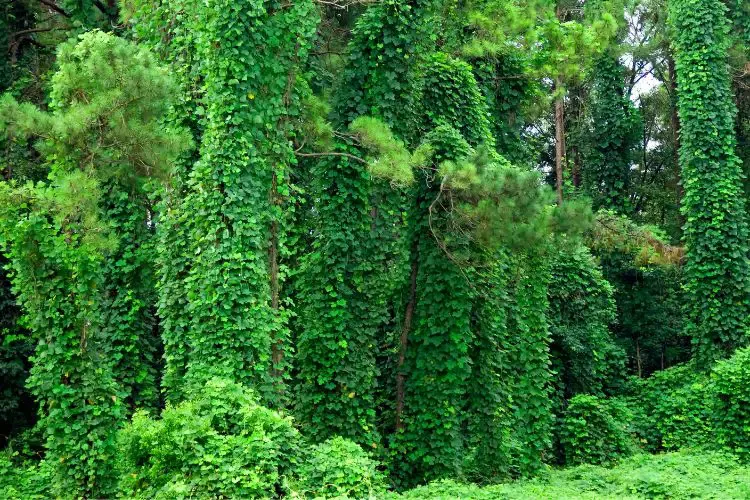
Meet Kudzu, the Usain Bolt of the plant world. It’s fast, relentless, and it won’t stop until it’s smothered every inch of your garden in a thick, green blanket.
Hailing from the East, this pernicious vine has now spread to various parts of the globe. It’s earned quite a reputation, with some folks lovingly calling it “the vine that ate the South.”
Once Kudzu settles into your garden, it’s like trying to evict a stubborn squatter. Its roots can weigh up to 400 pounds and spread 12 feet deep. I mean, how audacious is that?
And, of course, it doesn’t stop there. No, it likes to play King of the Jungle, climbing over everything in its path – trees, bushes, the backyard gnome you named Alfred. In the end, your once-diverse garden turns into a green, monotonous Kudzu kingdom.
So if you don’t want to live in Kudzu land, it’s best to steer clear of this fast-moving, all-consuming green invader.
5. Japanese Knotweed (Fallopia japonica)
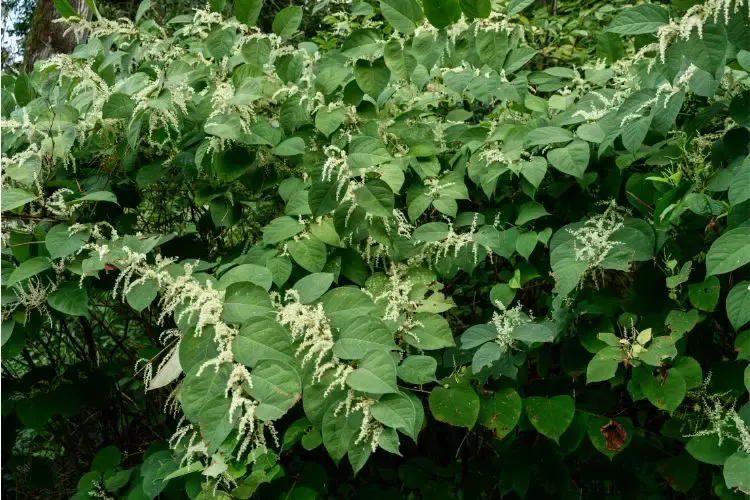
Next up, we have Japanese Knotweed, the Freddy Krueger of plants. I mean, this thing is the stuff of nightmares. It grows incredibly fast and can even push its way through concrete.
It’s not fussy about where it grows, either. Roadsides, riverbanks, lawns, cracks in your paving – this bad boy makes itself at home everywhere. I can hear it now, “Oh, a tiny crack in the pavement? Don’t mind if I do!”
And once it’s there, good luck getting rid of it. Even a tiny fragment of its root can grow into a new plant. It’s like that horror movie villain that just won’t stay down, no matter how many times you think you’ve defeated it.
So unless you want your garden to be the setting of “A Nightmare on Elm Street: Plant Edition,” I’d steer clear of Japanese Knotweed.
6. Giant Hogweed (Heracleum mantegazzianum)
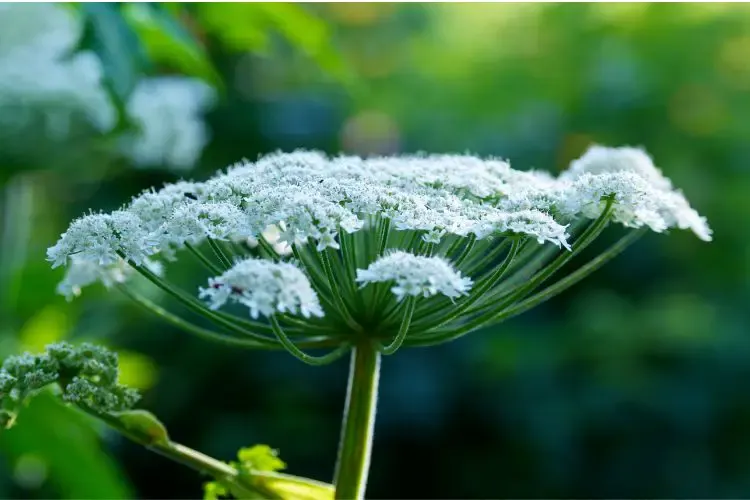
Let’s talk about a plant that takes its name way too seriously: Giant Hogweed. Now, I don’t know about you, but I prefer my plants to be gentle, soothing, maybe even a little nurturing.
Giant Hogweed? It’s none of these things. It’s a towering, toxic beast that seems to have wandered out of a Brothers Grimm fairy tale.
Just touching this plant can cause severe skin burns, and if the sap gets in your eyes, it can lead to temporary – or even permanent – blindness. It’s like inviting a very dangerous, very tall, and very rash-inducing ogre into your garden.
So, if you see this botanical behemoth, don’t try to tackle it yourself. Call in the pros. It’s just not worth playing “beat the ogre” in this instance.
7. Canada Thistle (Cirsium arvense)
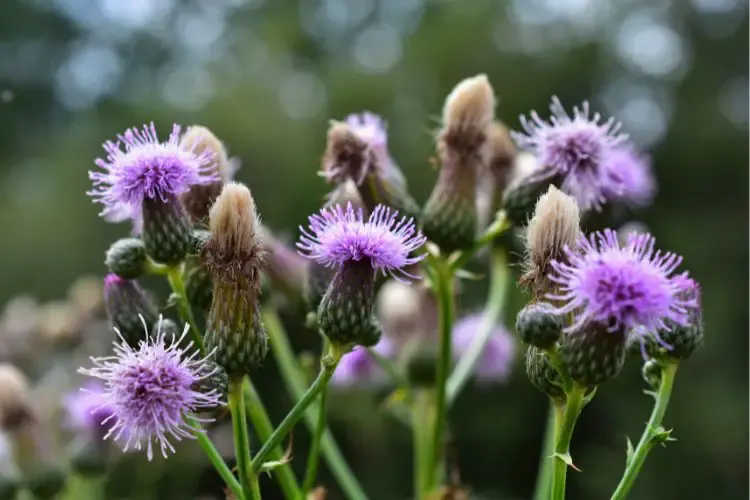
Despite its name, Canada Thistle didn’t actually originate in Canada (sorry, Canada, for the botanical false accusation). This prickly pest hails from Europe and Asia, and it’s been causing mischief in gardens ever since it arrived on new shores.
At first glance, it might look pretty with its pink-purple flowers. But let’s get real – it’s as welcome in your garden as a skunk at a picnic. Once it takes root, it spreads out its underground network of rhizomes and spawns a thorny empire faster than you can say “I should’ve weeded.”
And trying to remove it? Imagine trying to find a needle in a haystack, but the needle keeps moving and reproducing. Yeah, it’s like that.
This botanical menace also has a real talent for draining nutrients from the soil, leaving your other plants hungry and deprived. Talk about a garden diva hogging all the spotlight and the buffet!
So the next time you see a Canada Thistle, remember: it’s not as polite as the country it’s named after, and it sure won’t apologize for taking over your garden.
8. Mile-a-Minute Weed (Persicaria perfoliata)
Mile-a-Minute Weed certainly lives up to its name. This vine is like that overly energetic kid at a birthday party, bouncing off the walls, running around, and causing chaos.
Native to East Asia, it has been creating quite a mess in other parts of the world, too. It spreads – you guessed it – a mile a minute (not literally, but it feels like it), dominating landscapes, and wrapping itself around every plant it encounters.
Those cute little blue berries it produces? Yeah, they’re not for making pie. They’re for producing more Mile-a-Minute Weed. Birds eat them, fly away, and… you guessed it… poop out the seeds in new locations. Talk about a guerilla tactic!
Unless you fancy a garden that looks like a scene from “Jumanji,” it’s best to avoid this speedy intruder.
9. Water Hyacinth (Eichhornia crassipes)
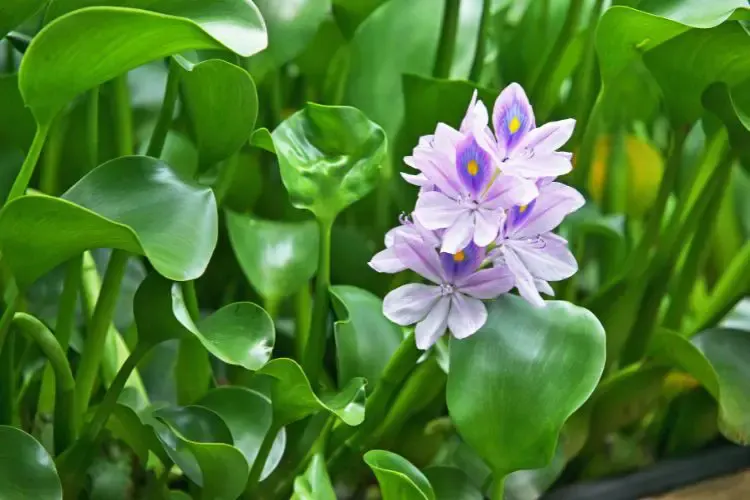
Here’s one for all you water feature enthusiasts. Water Hyacinth may look like a floating bouquet of purple flowers, but don’t be deceived. It’s as aggressive as a toddler on a sugar high.
Originally from the Amazon basin, it’s spread to water bodies around the world. It multiplies so fast that it can double its population in just two weeks. It’s like a botanical version of the “Gremlins” movie: cute at first, but then it gets wet and all hell breaks loose.
Water Hyacinth forms dense mats on the surface of water, blocking sunlight for aquatic plants, deoxygenating the water, and essentially throwing the entire ecosystem out of balance. Not exactly what you want in your koi pond, is it?
10. Garlic Mustard (Alliaria petiolata)
Garlic Mustard sounds like it could be a fancy condiment at a hipster barbecue. But in reality, it’s a European invader that has no respect for the personal space of your native plants.
This biennial plant might look harmless with its white flowers and garlic-smelling leaves, but don’t be fooled. It competes with native plants for sunlight, nutrients, water, soil, and the title of “Garden’s Next Top Model.”
In the fight against Garlic Mustard, even deer are our allies. They prefer native plants and tend to leave this garlic-smelling invader untouched, helping it stand out for gardeners to pull out.
11. Tree of Heaven (Ailanthus altissima)
And now for a plant with a heavenly name but devilish intentions: the Tree of Heaven. Sounds divine, doesn’t it? But this tree, native to China, is more of a fallen angel.
It grows quickly, reaches great heights, and is not fussy about where it sets up shop. Roadsides, urban areas, fertile soils, rocky terrain – the Tree of Heaven isn’t picky. It’s like that guest who shows up uninvited and then refuses to leave.
The Tree of Heaven produces allelopathic chemicals, which basically poison the soil around it, preventing other plants from growing. Kind of a “if I can’t have you, no one will” scenario. Not very heavenly, is it?
And let’s not even talk about the smell. When you crush its leaves, the stink is…let’s just say, it’s far from divine. So unless you have a thing for stinky, bullying trees, best to avoid the Tree of Heaven.
12. Yellow Archangel (Lamiastrum galeobdolon)
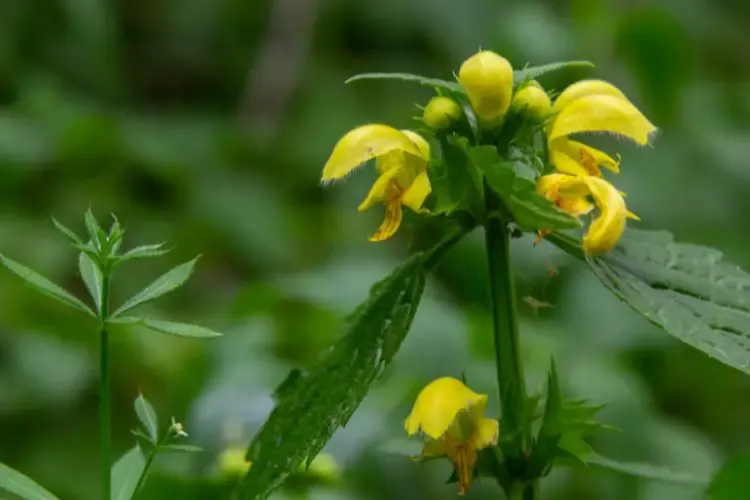
Last on our list is a plant with a name that’s just too cool for school: Yellow Archangel. It sounds like a comic book superhero, but trust me, it’s no hero.
This plant is an escape artist, originally a popular ornamental plant, but it decided that staying in one place was not for it. Instead, it likes to spread out, take over, and push out any competition. Your native plants don’t stand a chance.
Its silvery leaves and yellow flowers might look pretty, but don’t let that fool you. Yellow Archangel spreads like a gossip in a small town, and removing it is a bit like trying to remove glitter from a shag carpet.
In other words, if you don’t want your garden to become a Yellow Archangel fan club, best to keep this faux superhero out of your landscape.
Final Thoughts
Well, there you have it, folks! Twelve invasive plants you definitely don’t want to invite to your garden party. Remember, while these plants might look tempting with their rapid growth and flashy looks, they’re more trouble than they’re worth.
A garden should be a harmonious blend of plants, all getting along, all sharing resources, and all looking fabulously good while doing it. By keeping these invasive plants out, you’re ensuring your garden remains a paradise for you and the local wildlife.
Happy gardening, everyone! Keep those green thumbs working and those invasive plants at bay. As the great Ron Finley said, “Plant some shit.” Just make sure it’s not one of these invasive bad boys. Now, where did I put my trowel…?

